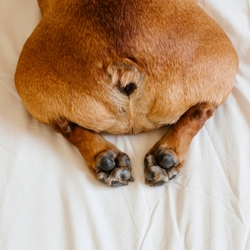
How to safely remove a tick from your dog
Spending time outdoors with your dog is great — until ticks enter the mix. Here's what to do when you come across one of these pesky parasites.
Between the warm weather jaunts of summer and the brisk hikes of fall, this is the time of year to be on especially high alert when it comes to ticks in your pooch’s fur. Because these guys are so tiny, they can often be hard to spot at first, and once you do spot one, it can be tough to remove it because of it’s super strong grip. Thankfully, we’ve got you covered when it comes to how to catch ticks early and what to do if you spot one on your pup.
What are they, and how are they harmful?
Ticks are itsy-bitsy tiny eight-legged arachnids. But unlike they’re size might suggest, these parasites are mighty dangerous. Why? They live by feeding on the blood of mammals (like you and your doggo), birds, sometimes reptiles and even amphibians. Their vampire-like habits make them the perfect carrier for diseases such as Lyme’s, Rocky Mountain spotted fever, ehrlichiosis and anaplasmosis - thus making them extremely hazardous. While they are present in all parts of the world, they are most commonly found in warm, humid climates camping out in high-grass, trees, shrubs and leaf piles.
How to detect them?
Anytime you take your pup out for a walk in the park or on a hike in the great outdoors, it’s good to check him or her for ticks before heading back home. Search for a small, flat and oval black blob at the base of your pup’s hair. Be thorough — forage through every nook and cranny; strand and hair. Don’t have 20/20 vision? Increase your odds of spotting ticks by grabbing a magnifying glass. You can also run your fingers over your pet’s skin to see if you can feel a tick out. Inspect any bumps you come across; they’re most likely ticks. Ahh, looks like you found one — now what?
How to safely remove them?
- Before starting the removal process, make sure your pet is in a calm state and in an environment he or she deems safe.
- With the help of a friend, hold your pet down and part your pet’s fur, revealing the tick’s location.
- With a tweezer, tick removal hook, or tick twister device, pull the tick from your pup’s skin. Make sure to grasp the tick as closely as possible to the skin to remove its mouth in the process. Why? If you only remove the body, the remaining mouthpart can cause a skin infection.
- Dispose of the tick by flushing it down the toilet, drowning it in alcohol, or wrapping it in duct tape. Make sure to disinfect the small open wound with rubbing alcohol.




Comments: